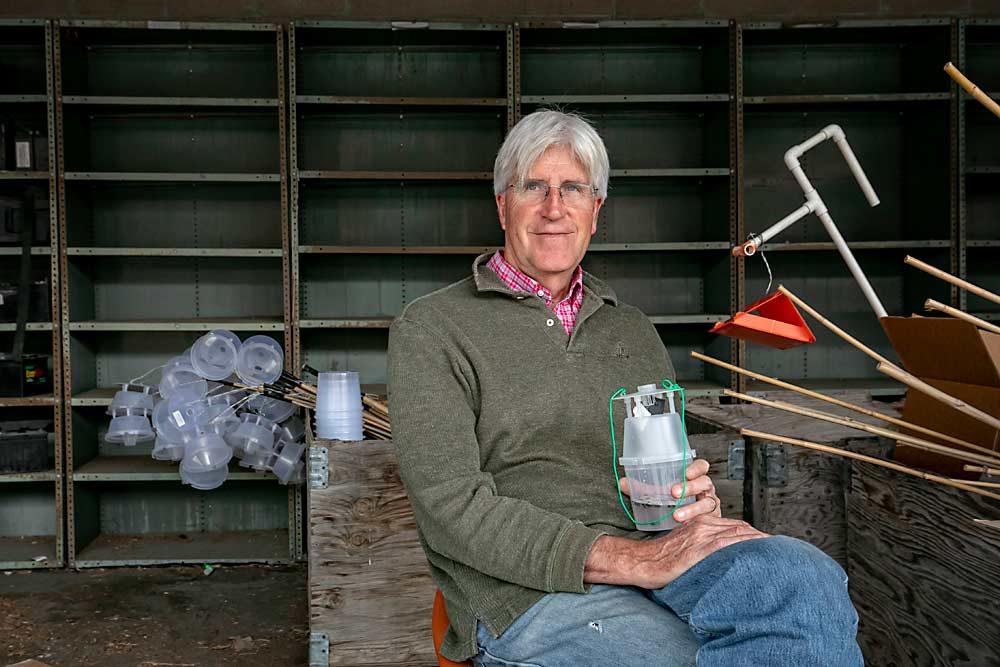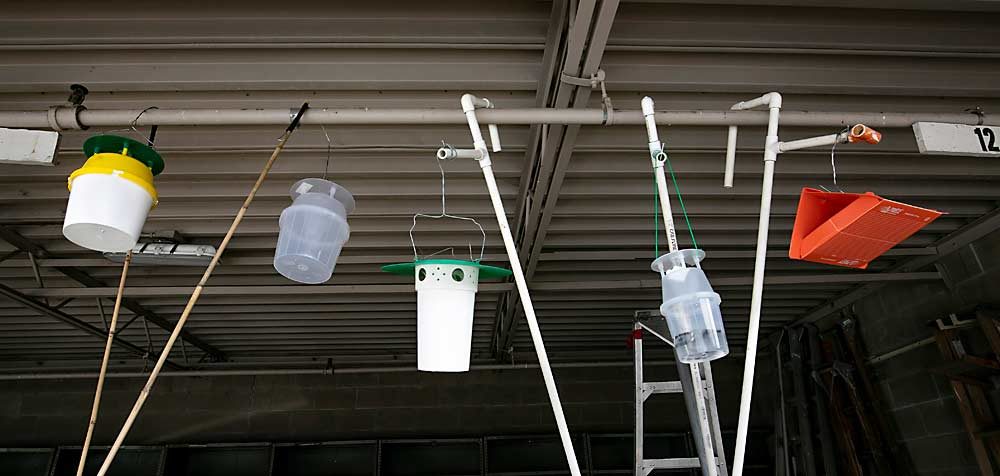
Entomologist Alan Knight was getting ready to retire last year, when he discovered “the biggest thing of my career”: new plant volatiles that dramatically increase his ability to lure and trap female codling moths. The new lure opens the door to trapping for pest population control, not just monitoring.
That’s saying a lot, since 20 years ago he and Doug Light, both U.S. Department of Agriculture researchers, discovered that pear ester posed a powerful attractant to both male and female codling moths, allowing monitoring even in orchards using mating disruption. Combined with pheromones, it’s become the industry standard.
But entomologists never stop looking for better lures.
A few years ago, after colleagues Gary Judd and Peter Landolt discovered that adding acetic acid to pear ester significantly boosted female catch, Knight decided to see if the new lures could power a mass trapping strategy to improve control of the pest in organic orchards, not just monitor them.
“The organic people, it’s clear, they are living with a certain level of injury and they need additional tools,” Knight said. “We need to change things because it’s not working for a lot of growers.”
That possibility is looking even better after last year, when he discovered that adding two additional plant volatiles to the pear ester and acetic acid combination increased his ability to trap females fourfold. The two additional compounds: linalool oxide, a flower aroma identified by a Swedish entomologist studying a grape pest; and nonatriene, a volatile that plants release in response to insect feeding.
So how did he stumble upon the new lure components?
“A 30-year career allows a person to know enough and know the right people to get lucky, I guess,” Knight said.

Testing trapping
Last year, Knight started his mass trapping trial with 24 traps per acre, using the pear ester and acetic acid lures. Injury rates dropped from 6 percent to 2 percent in a Wapato, Washington, orchard that was struggling with codling moth, despite a full organic management program.
The idea is to create a set-and-forget pest control program with bucket traps and long-lived lures. Knight believes the traps will only need to be touched three times a season: when they are set out, for a lure replacement midseason and for removal after harvest.
This season, Knight officially retired so that he’d have more time to be on the road running the trial, which now encompasses over 3,000 traps at 35 orchards in Washington, Oregon, California and Colorado. All use the new four-component lure, which manufacturer Trece is now testing for commercialization as well, or a five-component version including pheromone.
“I’m working so much with actual growers, which I never have before,” Knight said.
His study compares traps, as well, looking at traditional colored bucket traps, clear bucket traps, mini bucket traps and milk jugs with 2-inch-wide holes cut into either side of the handle. So far, the gallon milk jug is leading in terms of catch, Knight said, perhaps because the openings are so large.
Codling moths fly at dusk, when it’s still light enough for them to see, and tend to shy away from white traps, which is why orange is preferred for monitoring traps, and Knight is favoring clear buckets.
Traps, of course, cost money — about $7 to $10 per reusable trap, or 70 cents for a single-season-use milk jug. But Knight thinks the approach may be able to out-compete, on a cost-per-acre basis, the sterile insect release via drone that some organic growers are trying.
“Nothing is free,” Knight said. “Back in the day, we had to give growers $50 off per acre to get them to use mating disruption, but as soon as the free money ended, they cut their rates. They were saying they wanted to spend about $60 an acre on mating disruption, that’s what it was worth to them.”
So, he focused his work on finding effective technology in that price range, but now the bar has moved.
“With organic Honeycrisp, they are not batting an eye at $310 an acre for sterile moths,” he said. “My challenge is that I want to set up $310 of mass trapping versus $310 of sterile moths, and may the best technology win.”

The most alluring
With mass trapping, researchers don’t really care if they catch males, but what they really want is the females.
“As far as females are concerned, this is the best lure we’ve discovered,” said Judd, a chemical ecologist at the Summerland Research and Development Centre in British Columbia. He’s collaborated with Knight on many lure trials but is not part of the trapping trial. “Finding good female attractants is the holy grail of chemical ecology.”
The trapping approach makes sense to target hot spots or work in conjunction with mating disruption or control through sterile insect release, Judd said. Both of those techniques work best when populations are low.
“It could be a nice supplementary tool to get populations down to a level where mating disruption will work again,” Judd said. “It makes sense because mating disruption is really targeting the ability of males to find females, so the two are very complementary.”
More work is needed, however, to understand how the catch with these potent new lures relates to population size, as well as how trap catch impacts injury rates and how many traps per acre are needed to get good control, Judd said.
Even though there’s much more to learn, it’s an exciting time in codling moth control, Knight said.
“There’s more new stuff going on now than since we implemented mating disruption,” he said. “It has the opportunity to totally change things for growers.”
—by Kate Prengaman
New leafroller lures, too
U.S. Department of Agriculture entomologist Alan Knight’s interest in the mass trapping approach to organic pest control actually started with his work on a leafroller lure several years ago.
He and Gary Judd, a chemical ecologist at the Summerland Research and Development Centre in British Columbia, found two plant volatiles that significantly increase obliquebanded leafroller and eye-spotted bud moth catch, when used in conjunction with acetic acid.
“It’s an exceptional lure,” Judd said. Trece is commercializing it.
Knight planned to run trapping trials with it but had trouble finding significant enough OBLR populations in Washington orchards to sustain a trial. Judd just launched mass trapping trials for eye-spotted bud moth in British Columbia this year.
“I know we’re catching lots of eye-spotted bud moth, but is it reducing damage? We won’t know until the end of the season,” he said.
—K. Prengaman






Leave A Comment